At the end of January, we took a close-up look at some silk embroideries from the Suzhou region of China, specifically those created be the Su Embroidery Studios. The studio continues the tradition of Chinese needlepainting from this region, by offering various types and grades of Chinese needlepainting, as well as custom reproduction work.
After highlighting the work of Su Embroidery Studios, you can imagine my delight when I received in the post a couple week ago a beautiful piece of Suzhou embroidery for my very own, as a thank you for highlighting the work of the studio! So of course, I want to share it with you, too, so that you can see the piece up close. A study of it provides an interesting lesson in color combinations to produce a given effect.
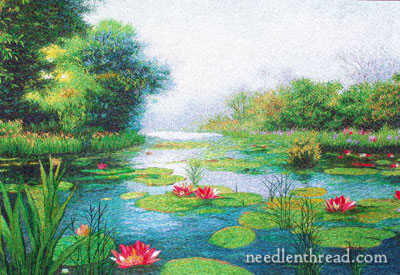
This is the needlepainting, an embroidered reproduction of a painting called “Meadows of Light.” It looks rather small in the photo above, but in fact, the finished embroidery is about 24″ x 16″. On the website, it is listed as a “fine quality” embroidery – not their top quality work, but work that is well above tourist-grade embroidery. I think it’s a very pretty scenic picture, a little reminiscent of impressionist painting, with its hazy background, subject, and color combinations.
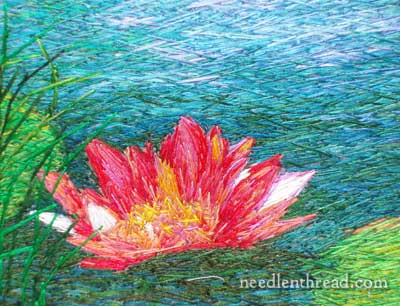
The vivid waterlies really catch the eye. If you look at them up close, you can see that they are stitched in at least 8 shades of silk. Notice the way the water and the depth of the water is created, with cross-hatched stitching in various blues, greens, and turquoise.
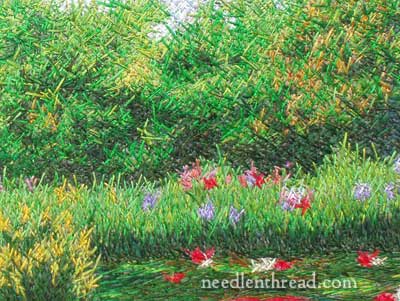
The trees and foliage along the shore are also created with this cross-hatched stitching. The colors are worked on top of each other, to create depth and light.
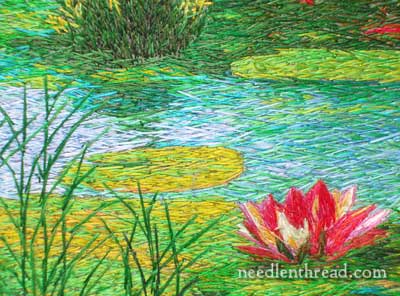
Another example of the water, with its reflection of the shoreline plants. Just as the painter doesn’t set out to paint water with one flat color of blue, so the needlepainter, when stitching water, doesn’t just rely on a few colors of blue to achieve the look of real water. Instead, you can see that bright greens and even yellows, and several shades and tints of blue, are all worked together in layers to create the watery surface.
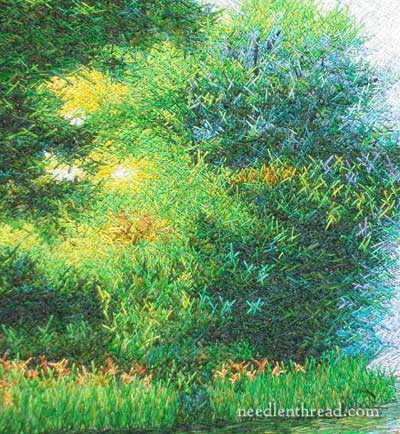
Distant trees and trees in the forefront reflecting the light of the sun come to life through a combination of dark to very light and bright greens, as well as bright yellows, white, and blue.
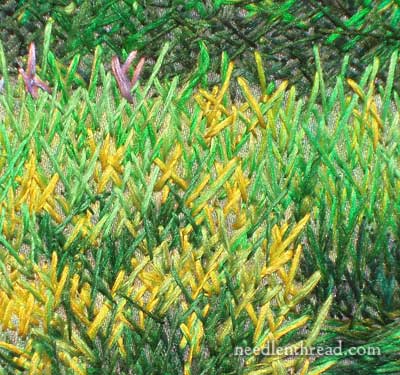
Now, to get right up to the stitching. Notice that the stitching on this piece is mostly straight stitches that criss-cross each other, and build up in layers to create the just the right effect. If you look carefully at the photo above, you can catch a glimpse of the fabric background of the needlepainting. The background fabric is a very thin silk onto which the painting is actually printed. The embroiderer works over this printed painting, building up stitches until the right effect is achieved.
I love looking up close at the colors in this piece! It is actually the combination of colors to achieve the painted effect that captivates me! Quite a few colors are used in the needlepainting, and in fact, I’ll show you some of the Chinese silk that’s used in this embroidery in a later article, if you’d like.
Thanks to Su Embroidery Studios, Chunhua Mao, and the stitcher who stitched “Meadows of Light,” for the beautiful needlepainting and the opportunity to see this type of embroidery up close! I’m certainly delighted to have the piece hanging in my home.
If you’d like to see some more close-up photos of high quality Suzhou embroidery, make sure you check out my previous post. I’ve also reviewed the book Threads of Light which focuses on the embroidery of the Suzhou region of China.







Dear Mary, I can’t think of anyone more deserving of this embroidery piece! It was such a joy to look at it and how it was put together. I am still in my infancy regarding needle painting but I enjoy every stitch I am making.
Have a wonderful weekend. Lots of love Elza.
Good morning, All! Thanks for your comments!!
Hi, Elza – this is a completely different “style” of needlepainting than what we are used to. Don’t think Trish Burr here – instead of stitches that flow into each other smoothly, this particular piece is made up of layer on layer of small straight stitches, built up over different colors, to give the effect of the overall picture. It’s fascinating to see it up close!
Hi, Laura – the back is covered. The silk piece is backed by a piece of stiff linen-like material (stiffened probably with rice glue, is my guess?) and then the sides of the silk on the front are covered with a very thin goldish-colored fabric, up to the edge of the embroidery. This is then overcast, it looks like, with tiny stitches around the edge of the embroidery, giving the effect of a kind of fabric mat. The outer edges of the whole piece are finished with what looks like a fine folded ribbon over the edge, glued down. It’s very “complete” in its finishing! I’m not exactly sure, though, how to go about having it framed!
Hi, Tina – yes, Threads of Light is a fascinating book. It was hard for me to tear away from it. I found myself reading large chunks at a time (when I should’ve been doing other things!) and the photography is, of course, magnificent! The needlepainting is certainly more glorious in person – pictures just can’t do it justice!
~MC
It is a beautiful picture.
Could you show us the back? 🙂
Hi Mary. How lucky you are to be given such a magnificent piece of embroidery. I borrowed Threads of Light from my local Guild and after spending an hour looking through it decided I wanted my own copy so I could spend time actually reading about this amazing art. It arrived a couple of days ago and I’m looking forward to finding out more. I can imagine it’s unbelievable to see it in the flesh so to speak. I’m sure you’ll enjoy it for years to come.
What an extraordinary gift! And an utterly beautiful piece of art!
How amazingly lovely, and what a stunning gift! I wish I were that lucky! I also wish I were this skilled – embroidery at this level just seems completely beyond my reach. I can only look in awe!
Beautiful. And so “artful”. A different slant on “needle painting”. Thank you for discussing the work. It is always so interesting (and fun) to listen to you! I always get my “horizons expanded!!” Thank you, Mary.
How exciting! That is a truly exquisite gift. I wonder how long it takes them to stitch something like that.
I would love an article about the silks used.
What a wonderful gift! And it’s a great example of how sometimes you can’t judge what a project will look like unless you stand back and look. I have a book about painting the fabric and then embroidering, but it certainly was not about doing anything like this.
Absolutely gorgeous. Thank you for sharing it!
What a wonderful gift, its so beautiful. I can’t wait until I’m more experienced at needlework, my goal is to work towards needle painting and goldwork.
Mary could you tell me where you buy your Italian silk from i’ve been looking on the internet but can’t find websites for Italian silks.
Anita Simmance
Hi, Anita – I actually get my silk at the more up-scale bridal fabric shops. Not JoAnn’s or Hancock’s or places like that, but locally owned specialty shops. There’s one in Kansas City that I’ll stop in when I’m over that way, called Kaplan’s. I have to haggle a bit on price now and then, because they tend to be pretty expensive, but the quality is far, far better, so for fine embroidery projects (like ecclesiastical work), I opt for the better stuff. It makes a huge difference in the finished results! ~MC
Thanks Mary I will search on specialists shops.
You have a lovely, lovely piece of work here, Mary; and it is so different to the usual type of Chinese embroidery that is more like, as you say, the Trish Burr style. Gorgeous work in its own right, but this is so impressionistic and the colours are fantastic. I too would like to see your silk threads and find out more about your sources for them.
A fanastic gift, Mary. What a thrill for you to recive. We are fortunate that you can give us your perspective up close on the detail of the stitches, back, and silk, etc.
I look forward to your next article on the silk used in this embroidery as I would like to buy some and do needlepainting myself. Even better would be the fine silk gauze fabric with a printed pattern on it.
Can you tell me if suzhou embroidery is taught anywhere in the boston, ma area